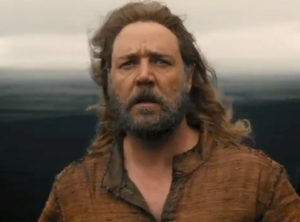Noah’s Ark Back in the Headlines!
It happens with movie stars, athletes, authors, politicians and more. One day you’re out – a has been – and the next day you’re back on top. So it is with the Biblical Noah. He had to wait a few thousand years to resurface in the headlines but here he is – and he’s back with a vengeance. A major Hollywood movie is being produced by Israel’s own Arnon Milchan, the main man at Regency Films (they’re the people behind “12 Years A Slave”). The 130 million dollar movie will star Russell Crowe as Noah and is due out in March of 2014. The special effects are sure to be spectacular but the question is, what will the ark look like: will it look like a boat? A square, as in the Christian tradition? Or, will it be round as is now being argued by my friend, Irving Finkel, the British Museum’s keeper of the Middle-East.

Finkel is a legend. He’s also an incredibly likeable character. Long beard and pony-tailed, he seems more like a runaway from an aging hippie commune in Key West, Florida than one of the world’s expert on Cuneiform writing. But he is one of the world’s experts on Cuneiform writing. For those who don’t know, Cuneiform is a pre-alphabetic wedge-shaped form of writing that was invented in Sumer, modern Iraq i.e., the patriarch Abraham’s turf. Irving is very versatile. He is also the world’s expert on ancient games and he starred in one of my episode in my “Naked Archeologist” series, wherein I looked for the “Pur” i.e., the dice, in the Jewish holiday of “Purim”. Since the holiday is named after the casting of lots or die, I wanted to know what ancient games were all about and Dr. Irving took me on a tour of ancient games. He’s even written a brilliant book on the subject and resurrected several ancient games including “The Royal Game of Ur”, which for thousands of years entertained more people than Disney. Before telling you of Irving Finkel’s latest headline grabbing discovery, we should know that he was one of the main inspirations for the Middle-East who dun’nit “The Last Testament” by Sam Bourne, where one of the characters is based on him.
So what does Irving Finkel do in his spare time? He finds the earliest Cuneiform rendition of the Biblical story of Noah, complete with detailed instructions on how to build the ark. It turns out that it’s round – more of a coracle, a kind of round river boat that they used in ancient Mesopotamia. The find dates to about 1750 BCE i.e., before the Torah which, according to the Biblical narrative, was given to Moses during the Biblical Exodus. Some date the Exodus to the 13th century BCE, but the Bible itself dates the Exodus to around 1500 BCE. My movie, “The Exodus: Decoded”, argued the latter point. Meaning, it’s very hard to say that Irving’s find “predates the Bible”. After all, we are talking about events that happened nearly 4,000 years ago and they seem to be from – more or less – the same time period.

So even though I love Irving, I disagree with his assessment that his find necessarily predates the Biblical tale, or that it influenced the Noah story of the Torah. We have to understand what the Bible is claiming before we take issue with it. According to the Bible, a catastrophic flood took place that wiped out humanity, except for Noah and his family. In other words, according to the Bible, we are all descendants of Noah. If that is the case, you would expect to find a memory of this catastrophic flood in many cultures on earth. So when you do find a 60 line flood story on a Cuneiform clay tablet, no bigger than an iPhone, this is cause to celebrate. In no way does it undermine the validity of the Biblical tale, however. In fact, one can argue that it corroborates the Biblical story by providing an extra Biblical witness to a Biblical narrative. Put differently, the Cuneiform tablet and the story in the Bible may be reporting on the same event without having any relationship with each other. In today’s world, the same news story can appear in many newspapers. As discerning readers, we choose to trust one publication over another. This doesn’t mean that one publication influences the other. They’re all simply reporting on the same event.
So, I have three reactions to Irving Finkel’s find. First of all: “Way to go Irving!” Second of all, it’s very hard to say what predates what and what influences what. It could be that all the flood stories are not influenced by each other, but by an actual event. Finally, according to the Church Father Origin, the ark was square at its base. In the Jewish tradition, the Talmud doesn’t really talk about the shape, but it does say it was three-tiered. The medieval rabbinic commentator Abraham ibn Ezra (12th century) argued that it was a kind of submarine that stayed underwater for 40 days, until it floated to the top. He said this before anyone had conceived of a submarine. Now, Irving Finkel in his new book, “The Ark Before Noah”, claims that a 3,750 year old clay tablet, presently on display at the British Museum, reveals that Noah’s Ark was round.
To tell you the truth, I never imagined the ark as being round. I wonder what Russell Crowe thinks of this.


